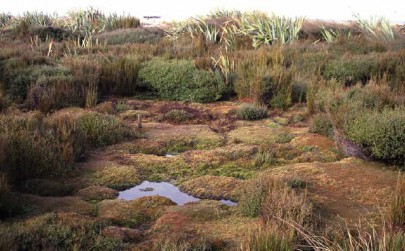Blanket mires
In this section

Blanket bog cushions of Donatia novae–zelandiae at Awarua Bog, Southland (Bev Clarkson)
Blanket mires are peatlands (i.e. bogs and fens) that extensively cover the crests, slopes, flats, and hollows of an undulating landform, usually of low relief. If the blanket mire is wholly rain-fed, it is termed a blanket bog. Typical species include Sphagnum mosses, Empodisma minus, Dracophyllum spp., manuka, tangle fern, cushion plants, red tussock and Sporadanthus traversii. Dominance of sedges, shrubs and trees, e.g. Dracophyllum arboreum on Chatham Island, reflect areas where drainage and fertility are marginally better.
Synonyms
Blanket bog, featherbed bog
Notable flora and fauna
Threatened plants include nationally critical Juncus holoschoenus var. holoschoenus; nationally endangered hook sedge (Uncinia strictissima); declining swamp matipo (Myrsine coxii); recovering Chatham Island speargrass (Aciphylla traversii); relict bladderwort (Utricularia delicatula). Naturally uncommon species include Carex lachenalii subsp. parkeri, Chatham sedge (Carex chathamica), Chatham Island gentian (Gentiana chathamica subsp. chathamica), Campbell Island Gentian (Gentianella antarctica), swamp aster (Olearia semidentata), Leptecophylla robusta, Plantago aucklandica, Ranunculus maculatus, R. simulans, Chatham Island bamboo rush (Sporadanthus traversii), Pink swamp heath (Sprengelia incarnata) and Pterostylis aff. graminea (CHR 513330; sphagnum).
Notable fauna include fernbird (Bowdleria punctata), Australasian bittern (Botaurus poiciloptilus), brown mudfish (Neochanna apoda), and the ghost moth/sphagnum porina moth (Heloxycanus patricki).
Threat status
Vulnerable (Holdaway et al. 2012)
Threats
In inhabited areas, blanket mires are under greatest threat from drainage and agricultural/dairy development. Additional threats include fire (e.g. a large part of Awarua Bog in Southland was burnt in 2005), stock access and nutrient enrichment, e.g. from aerial drift of fertiliser. These systems are very fragile and susceptible to peat compaction and vegetation damage from hikers, hunters, etc.
Where do they occur?
Blanket mires are most common in cool, windy climates such as Southland (e.g. Awarua Bog), Westland, Stewart Island, and the subantarctic islands. On Chatham Island, Sporodanthus traversii blanket bogs grade into raised bogs where local conditions allow greater peat accumulation, producing discrete convex-shaped domes (= domed bogs (Sporadanthus)).
Further reading
Johnson P, Gerbeaux P 2004. Wetland types in New Zealand. Wellington, Department of Conservation.
Johnson PN 2001. Vegetation recovery after fire on a southern New Zealand peatland. New Zealand Journal of Botany 39: 251-267.
McGlone MS 2009. Postglacial history of New Zealand wetlands and implications for their conservation. New Zealand Journal of Ecology 33:1-23.


